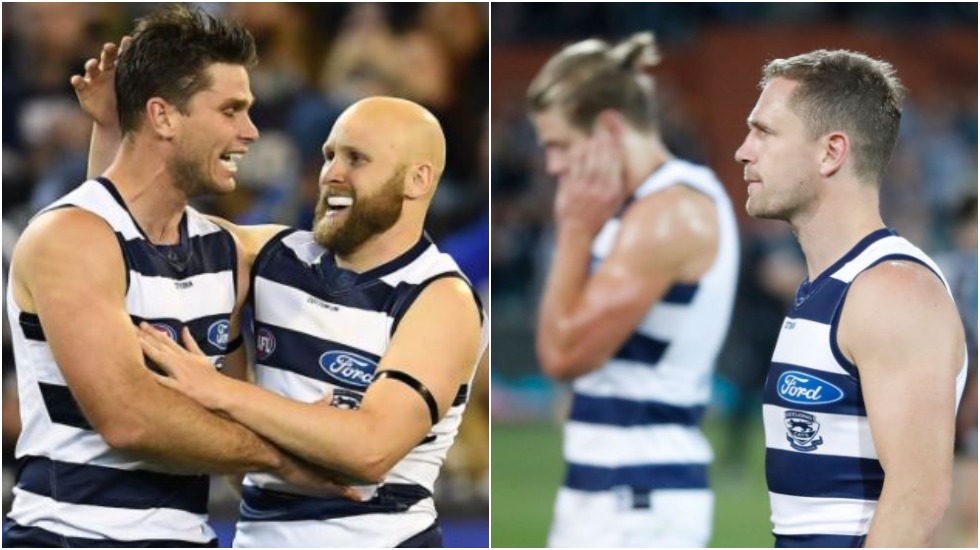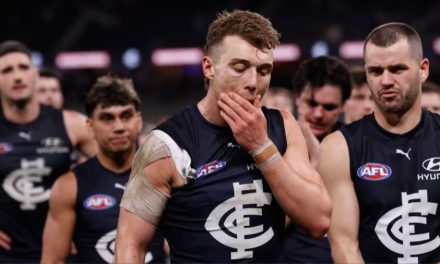Left: Tom Hawkins and Gary Ablett celebrate a 2019 finals win. Right: Mark Blicavs and Joel Selwood taste defeat last week.
We live in an age of forensic analysis of AFL football. There isn’t an aspect of the game these days that isn’t scrutinised to within an inch of its life.
Players, coaches and mostly fans want answers to every conceivable question about why teams win or lose. Mostly, they get them. But sometimes the answer lies not in contested ball numbers, percentages of turnovers scored from of time spent in the forward half.
Sometimes the answer is as simple and annoyingly pat as the fact that in a competition, someone has to win and someone lose. And perhaps Geelong is providing the definitive example.
The Cats go into another cut-throat final on Saturday against Collingwood with their scoreline in finals since their last premiership of 2011 a miserable-looking 4-12, a set of figures you’ve seen innumerable times already since they lost their qualifying final to Port Adelaide.
There wouldn’t be a rusted-on Geelong supporter out there who isn’t painfully aware of that figure, let alone anyone connected with the club, evidenced by coach Chris Scott’s snappy response to questions about that scoreline straight after the Port defeat.
You can understand the narkiness of the coach. He’s become an easy and familiar target for frustrated Cat fans in what is becoming a recurring theme. And Scott has more than enough evidence that in 10 seasons as coach, he’s more than done his job.
No, there’s been no more silverware since a premiership in his first season of 2011. But Geelong continually gives itself the best possible chance of winning some more, six times in nine seasons since then finishing top four (pre-finals) with a double chance.
In Scott’s 233 games as Geelong coach, his winning percentage remains a phenomenal 69.1 per cent. To put that in context, it’s easily the best strike rate of any coach of more than 200 games in AFL/VFL history. The next best on the list are Essendon’s Dick Reynolds (66.9 per cent) and Collingwood legend Jock McHale (66.1 per cent), two of the most revered names in football history.
Scott’s name isn’t accorded anywhere near the status of that pair. But had the Cats been able to parlay even a couple more of those top four finishes into flags, it might be a lot closer.
Perhaps fans of clubs which haven’t been near finals with anywhere near the regularity Geelong has in the modern era would be more appreciative. Then again, Cat fans perhaps also have more reason for frustration than most.
Older Geelong supporters know this storyline well. In the late 1980s and early to mid-1990s under first Malcolm Blight then Gary Ayres, they watched their free-flowing, high-scoring team filled with stars consistently get close, but not quite close enough to the promised land.
The Cats famously fell one goal short in 1989 against Hawthorn, arguably one of the greatest couple of VFL teams of all time. In 1992 and 1994, they handled everyone with ease save for the defensive steel of West Coast, which had their measure. And in 1995, they came up against a Carlton which lost just two games out of 25 for the season.
In the AFL era of 1990-2020, only Hawthorn (five) and West Coast (four) have won more premierships than Geelong’s three. But for consistency of performance over the entire period, even that pair haven’t been as reliable, the Cats’ winning percentage over the journey almost 56, ahead of West Coast on 54 and the Hawks on 51. And under Scott, Geelong keeps giving itself a chance.
PLEASE HELP US CONTINUE TO THRIVE BY BECOMING AN OFFICIAL FOOTYOLOGY PATRON. JUST CLICK THIS LINK.
Of course that hasn’t stopped the quest for answers to why Geelong keeps falling short. Even the questions have become familiar, though this season, a favourite – “is the Cats’ regular season success inflated by its significant home ground advantage?” – has been redundant.
But even prior to 2020, that query was questionable. Under Scott, Geelong has won a massive 86 per cent of games at Kardinia Park (under its various corporate guises). But it’s been pretty handy elsewhere, too, winning nearly 53 per cent of all games at the MCG (even including those losing finals) and nearly 60 per cent elsewhere.
Is it about age? Well, Geelong might have fielded the oldest team in league history against Port Adelaide, but firstly, the Cats haven’t always been that old, and second, those old legs were good enough to blow Port away by 10 goals only seven weeks ago, and last year, were fresh enough to lead eventual premier Richmond by 21 points at half-time in a preliminary final.
Is it structure? Not in my view. The lack of a dominant ruckman is often cited as a Geelong weakness, but last year’s qualifying final loss to a Collingwood boasting a dominant Brodie Grundy aside, it hasn’t often proved critical to the Cats’ finals defeats.
Defence? Offence? Geelong has stacked up well in both areas for a long time, ranked top four for both points scored and fewest points conceded for the past three years, first for points scored this season and with statistically the best defence in both 2018-19 (fourth this year).
And it’s not as though the Cats could have done a lot more to counter perceived weaknesses. Class? They went out and got Patrick Dangerfield and engineered the return of Gary Ablett. Pressure in the forward 50? At their absolute peak early last season, introductions like Luke Dahlhaus, Tom Atkins and Gryan Miers had huge impact in that department.
Ball movement? Yes, Geelong can be conservative at times. But remember also its blistering seven-goal final term in that 60-point drubbing of Port Adelaide back in round 12. This is a side which can move the ball at speed with the best of them.
So what’s the problem? It might not be any consolation, but perhaps, over and over, it’s been little more than what Blight and Ayes lamented 30-odd years ago. That as good as Geelong has been, there’s always been a rival or rivals just that little bit better.
In 10 seasons under Scott, Geelong has won, as you’d expect, 74 per cent of all games against sides it would finish higher than on the ladder. Against teams it finished lower than in the regular season, the figure is 40 per cent (this season, including last week, the Cats are 10-4 or 71 per cent on the first count, 2-2 or 50 per cent on the second).
Being able to win four out of 10 games against side which performed better across the season isn’t necessarily too shabby, mind you. But it also might place in a better context that dreaded 4-12 finals record since the glory days of 2011.
Geelong has done the fundamentals very well and very consistently under Scott for a long time now. But the Cats have been far from perfect. There’s no chronic weakness or failure, but in a Group One two-horse race like finals football, sometimes the other nag is just that tiny bit better. And yes, sometimes it really is that simple.
This article first appeared at ESPN.












Cats won fabled 11 in a row v Hawks. 10 of however were home and away games. Last match before the curse was 08 GF and first match post was 13 PF (Hawks going on to win GF). Cats are the Graham Hick of the AFL – flat track bullies. Kardinia Park as a H&W fortress counts for naught in finals. And as for Scott’s win loss percentage – WTAF cares? Clarkson has FOUR flags.
Thanks for this very interesting commentary Rohan. You’re right about the other nag being just a little bit better. However, as a rusted on Cats fan, I keep getting stuck in the knowledge that we get handily beaten by teams in finals that else matched or bettered during the season. I guess all of us in the Cats’ base are haunted by the spectre of handbags.